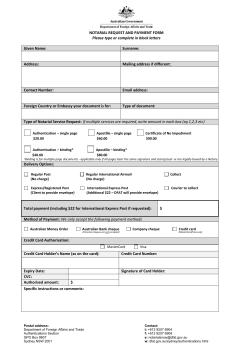
An Open ID Media Standard is Within Reach_Chris
BINDING IDS TO CONTENT A PROGRESS REPORT APRIL 2014 Chris Lennon President & CEO MediAnswers Chair of Open ID Project What Problem Are We Trying To Solve? Currently, there is no open method for embedding persistent content identifiers (e.g., watermarks, fingerprints, etc.) into content, so that it survives, no matter how that content gets to the consumer Broadcast TV and Film Retail and Consumer Products ID Registration SKU Binding Binding Distribution Distribution UPC No guarantee of survivability ID Registration Consum Consumer er Content creators and distributors need an effective way of reliably binding content identifiers to audio/video content that will robustly and reliably transit an end-to-end media ecosystem Existing identifiers, such as EIDR and Ad-ID, rely on binding an identifier to a file container, data streams within a file container, or structural metadata of the file itself, which can be destroyed during processing or delivery. Research suggests that the only reliable approach is to bind the identifier within the audio/visual essence, so that it can survive throughout the end-to-end lifecycle. Binding technologies exist – watermarks, fingerprints and wrappers – but today these are either proprietary, are not capable of surviving transit through the end-to-end ecosystem, or both. Content creators and distributors need an effective way of reliably binding content identifiers to audio/video content that will robustly and reliably transit an end-to-end media ecosystem An open standard for ID-to-asset binding can enable a wide array of capabilities: Increased speed, transparency and accountability in video content and advertising measurement Fewer barriers to deploying cross-platform dynamic ad insertion More complete longtail content monetization More granular and comparable media ratings Improved automated content recognition and detection On-the-fly media asset assembly Reduced asset storage and transmission costs Improved media workflow automation within and between M&E entities Enablement of new anti-piracy tools and methods Accelerated digital content locker adoption Better second-screen integration and improved multi-screen content discovery Simplified and less-costly media reconciliation • Where is this work being done? What Has Happened Up To Now? • Meetings every other week since group formed in July of 2013 • Use Cases , and then Requirements created • RFI issued Dec 15, 2013 • RFI closed Jan 31, 2014 • Face To Face Meeting Feb 11, 2014 (6 formal, 2 informal replies) Some Use Cases The Group Identified Cross Platform Measurement Second Screen Applications Audience Measurement 4 Rs: Rights, Research, Royalties, Reconciliation Targeted Ad Insertion (Advanced Advertising) Requirements • At the RFI’s core were a set of requirements. These came out of use cases discussed on the previous slides. Requirements • Payload – Must be able to carry representations of Ad-IDs and EIDRs Requirements • Survivability Across Platforms – Must survive distribution to consumers across all distribution platforms Requirements • Recording And Playback – Must survive recording and playback at a later time (DVRs) Requirements • Granularity – Need to be able to detect the IDs during short commercials, as well as longer programs. Requirements • Synchronization Across Platforms – Must be able to retrieve IDs simultaneously across different platforms (second screen) Requirements • ID Replacement – Must be able to replace the ID if content is repurposed within another program (e.g. SportsCenter) Requirements • Quality – Must not degrade the quality of the content for the consumer What Kind of Responses Did We Get? • Most solutions focused on audio watermarking, although other solutions were presented (fingerprinting, XDS carriage, Time Reference Label, whistles, video watermarking) What Kind of Responses Did We Get? • Although watermarking was dominant technology presented, there may be advantages to coupling this with fingerprinting or other technologies • Example: audio watermark establishes that ad played, and fingerprinting verifies that entire ad played Next Steps • Group to focus on full report to SMPTE, outlining suggested standardization work to achieve Open ID binding to essence. Thank You Questions? clennon@medianswers.tv
© Copyright 2025





















